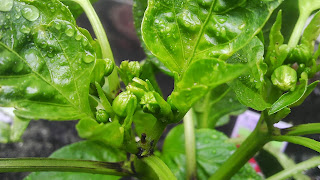Let's learn about the beautiful & tasty tomatillo
It won't be this sciencey but might include Latin
(you've been warned)
Let's start with the some fun alternate names for the tomatillo: "Husk Tomato", "Jamberry", "Husk Cherry", "Mexican Tomato".
The tomatillo is native to Central America and was domesticated around 800 B.C.
( see how it went from fun to facts there... it's going to be a wild ride )
There are two main types of tomatillo ( here comes the Latin )
Physalis ixocarpa : This is the tomatillo you most often see at the market. It's fruit is green and around 2 inches across, it's flavor is tart and it ripens to a pale shade of yellow ( much like our dining room if you have ever been over for dinner )
Physalis philidelphica : The lesser known of the tomatillo family ( maintaining it's amateur status ) is a slightly sweeter version of the tomatillo we all know and love except it is also purple and grows to a marble size.
The tomatillo is part of the nightshade family ( Solanaceae ) meaning it is related to the tomato, the potato and the eggplant. Not only are the family reunions weird but they are delicious.
When given plenty of sun and well drained and very rich soil they will produce a very high yield.
Speaking of harvest... transplants will be ready to harvest around 70 - 100 days. You will know to pick when their husks ( or vascular tissue ) begin to split off of the fruit.
not entirely accurate view of splitting tomatillo
more of a stripping tomatillo
The reason I love that I am growing tomatillos you ask ? Well, It is because they are easy to grow. If grown in a pot and given enough drainage, they are very hard to kill.
Grow a tomatillo this year and share your favorite recipe with us













































